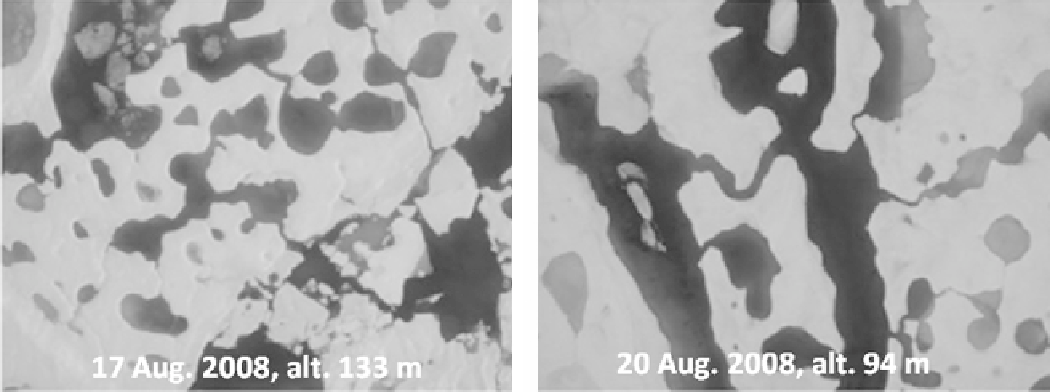Geology Reference
In-Depth Information
Figure 9.18
Aerial photographs showing Arctic sea ice (bright), melt pond on top of the ice surface (bluish gray),
and fully melted ice, i.e., seawater surface (dark). The photographs were obtained during CHINARE2008 field
campaign [adapted from
Peng et al.
, 2010, Figure 2, with permission from Elsevier].
cover 5% to 20% by mid‐June. After that, the growth con-
tinued at a slower but steady rate until it reached its peak
in early August. The two forces that determined the frac-
tional area of the ponds were the rate of surface melt
and the drainage of the water to the underlying ocean
through cracks and holes. From a series of images
obtained from a downward looking camera mounted on
the underside of a research aircraft, also flown over the
SHEBA site,
Tschudi et al.
[2001] found that the melt
pond areal fraction reached a maximum of 34% on July
26. Obviously, the areal fraction airborne cameras depend
on the observing area of the camera and for that reason it
should be normalized.
In a more recent study,
Peng et al.
[2010] analyzed
aerial photographs of Arctic summer sea ice obtained
during the Third Chinese National Arctic Research
Expedition in 2008 (CHINARE2008). Over 9000 photo-
graphs were acquired by a helicopter‐mounted Canon G9
camera. Sea ice was undergoing a transition period from
the late melting phase to the early freeze‐up phase. Using
the photographs, the authors could identify three com-
ponents of the surface: snow‐covered sea ice, melt ponds,
and open leads. Figure 9.18 shows two photographs
acquired on 17 August 2008 and 20 August 2008 from an
altitude of 113 and 94 m, respectively. The three surface
categories can visually be identified. Melt ponds have dis-
tinct shapes and spread across the ice surface forming a
large complex network. They appear in nature with a blue
turquois color because of the presence of sea ice under
the pond water. The snow‐covered ice surface appears
bright as expected. Leads appear much darker because of
their low surface reflectance. These shades were used to
identify each surface in the color images using simple
digital image processing techniques. The leads in the
image of 20 August in Figure 9.18 are larger and more
mature. A fraction of each component was determined
based on the differences of the brightness and colors.
9.4. froSt fLowerS
Frost flowers are fragile and highly salty ice crystals,
which grow to a height of 10-30 mm on the surface of
freshly formed sea ice and occasionally freshwater ice
[
Martin et al
., 1995]. Their origin is water vapor released
from the subsurface of the ice cover up through a porous
ice layer or sublimated directly from the surface. The
vapor may condense immediately under very cold atmos-
pheric temperatures especially if the air is vapor satu-
rated. This gives rise to frost crystal formation that
usually takes on dendritic shapes, although they may
grow in rod‐like morphologies; hence the name flower is
given. Frost flowers typically form if the ice surface tem-
perature is warmer than the air temperature by at least
15 °C, though this difference depends on the humidity of
the air and can be reduced under a humid boundary layer.
As the warmer, wet air near the surface meets the overly-
ing cold air, it becomes supersaturated and thus con-
denses to form hoar‐frost crystals based on the sea ice
surface. The nucleus could be any protrusion at the sur-
face. In addition to the large temperature difference
between the ice and the air, frost flower formation needs
also windless conditions. If wind blows at the ice surface,
the supersaturated layer is scrubbed from the surface and
the blowing snow also obscures the surface. Flowers are
most commonly observed on thin ice types (particularly
Nilas) because their relatively warm surface allows for the

